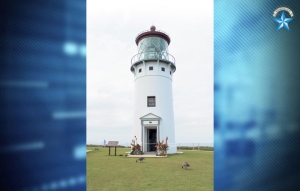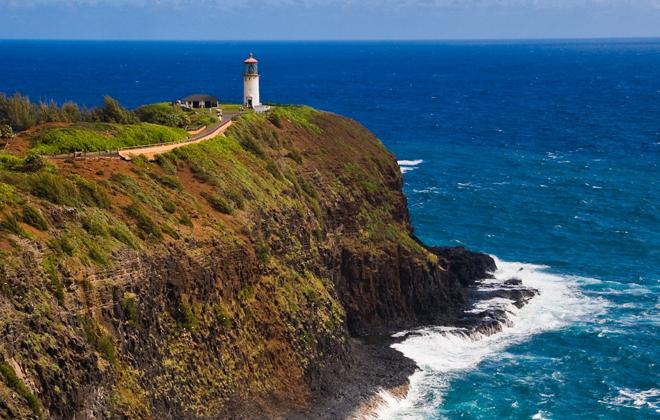Preservation in the News: a captivating tour spotlights the lighthouse at Kilauea Point National Wildlife Refuge renamed the Daniel K. Inouye Kilauea Point Lighthouse after the late Senator.
*********
Tours illuminate Kauai lighthouse’s beauty, past
Honolulu Star Advertiser, May 24, 2015
Old and worn — like a fisherman who’s spent too many days in the wind and sun.” That was Louise Barnfield’s impression of the lighthouse at Kilauea Point National Wildlife Refuge when she saw it on her first visit to Kauai in January 2008.
The senior manager for Oracle Corp. and her husband, who were then living in the San Francisco Bay area, visited Kauai five times after that before retiring there in August 2012. On four of those trips, they returned to the lighthouse and were happy to see restoration work underway.
“I started volunteering at the refuge the week after we moved to Kauai,” Barnfield said. “By then, the lighthouse was shrouded in scaffolding and tenting. A sign said the work would be completed for its centennial on May 1, 2013.”

COURTESY JILLIAN COSGROVE/USFWS The Daniel K. Inouye Kilauea Point Lighthouse, left. In 1909, the U.S. government purchased the 31-acre site for it from Kilauea Sugar Co. for $1 and allocated $75,000 for the project. Construction began in July 1912, and the station was dedicated on May 1, 1913. Its beacon could be seen from 20 miles at sea, 90 miles from the air.
Kilauea Point Light Station, later called Kilauea Point Lighthouse, guided ships past Kauai’s rugged north coast for more than 60 years (see sidebar). During its centennial celebration, it was rededicated and renamed the Daniel K. Inouye Kilauea Point Lighthouse to recognize the late Hawaii senator’s role in a spirited community-led campaign to raise funds for its three-year, $2.5 million restoration.
Barnfield enjoys leading weekly tours of the lighthouse, which began in May 2014. “People often think of lighthouses as obsolete structures, but we should remember they were marvels of engineering and innovation in their day,” she said. “Plans for Kilauea Point’s lighthouse were made soon after the big 1906 earthquake in San Francisco — a time when there was a push for stronger, quake-resistant building materials and methods. It was one of the first federal projects to use rebar-reinforced concrete, and, amazingly, it exceeds today’s industry standards.”
| if you go… DANIEL K. INOUYE KILAUEA POINT LIGHTHOUSE TOUR>> Location: Kilauea Point National Wildlife Refuge, Kilauea, Kauai >> Offered: Wednesdays, every hour on the half hour, beginning at 10:30 a.m., depending on the availability of guides (call ahead to confirm tours will be offered). The last tour starts at 2:30 p.m. >> Admission: Free; however, there is a $5-per-person entry fee to the refuge (no charge for children aged 15 and under). Admission to the refuge is free on Lighthouse Day, the first Saturday in May, which celebrates the lighthouse’s anniversary. >> Hours: The refuge is open Tuesdays through Saturdays from 10 a.m. to 4 p.m. >> Phone: 828-1413 >> Email: jennifer_waipa@fws.gov >> Website: fws.gov/kilaueapoint >> Notes: Tours are limited to the first 15 people to sign up within the hour prior. Participants must be able to walk up and down about 50 steep steps in a narrow spiral staircase on their own. This tour is not a good option for anyone with health problems. Children must be at least 44 inches tall and accompanied by an adult. |
At the start of the half-hour tour, she explains that because there were no roads when the lighthouse was constructed, all materials and equipment had to be brought to the site by sea. “A tender, the Kukui, which appropriately means ‘light,’ anchored in a cove next to the point,” she said. “From there, smaller boats transported the cargo to a derrick that lifted it to a platform halfway up the cliff. A narrow-gauge railway carried the supplies the rest of the way. This went on until roads to the lighthouse were built in 1927.”
In the Work Room on the first floor of the lighthouse, a shaft hints at how the lighthouse’s lens was rotated before electric motors did the job. Weights suspended on cables in the shaft were raised to the top of the building; as gravity slowly pulled the weights down, a mechanism akin to a grandfather clock turned the lens.
“Keepers had to manually wind the mechanism every 3½ hours,” Barnfield said. “An electric motor was installed in 1939, but the clockwork mechanism was so reliable it was kept as an emergency backup for many years.”
Originally made of cast iron, the two doors in the second-floor Service Room formed an air lock similar to a skyscraper’s revolving door. Prior to being replaced by an electric bulb in 1932, the lighthouse’s light source was an oil vapor lamp, similar to a Coleman lantern. To prevent air from rushing in and blowing out the lamp’s mantle, both doors were never opened at the same time. During the restoration, the original doors were replaced with stainless steel replicas to minimize corrosion.
Of note in the Watch Room on the third floor are 266 glass circles embedded in the ceiling, which let in light from the Fresnel lens in the Lantern Room on the floor above.
“Many of those original vault lights were missing or damaged beyond repair and had to be replaced during the restoration,” Barnfield said. “They were hand-blown and painstakingly tinted to match the exact purple tint of the original glass.”
Although tour participants aren’t able to enter the Lantern Room because of the fragile condition of the 4½-ton lens assembly, they can nonetheless climb high enough to get a close look at it. It was manufactured in Paris for $12,000 ($302,000 today) and comprises 400 prisms that were perfectly angled to reflect and refract light. Fifty-five inches in diameter, making it the second-largest type of Fresnel lens made, it produced a strong beam that appeared as a double flash every 10 seconds as the lens rotated.
“Lighthouses captivate people, whether it’s because of their history, their mechanics or the romance of a keeper’s isolated life by the sea,” Barnfield said. “I’m grateful for the opportunity I have to shine a light on a fascinating chapter of Kauai’s history.”
———
Cheryl Chee Tsutsumi is a Honolulu-based freelance writer whose travel features for the Star-Advertiser have won several Society of American Travel Writers awards.


